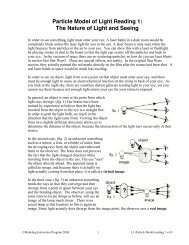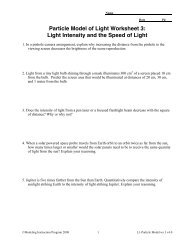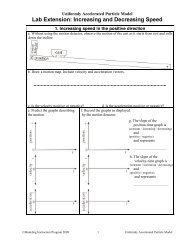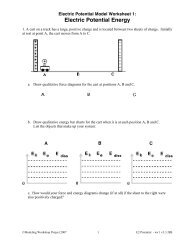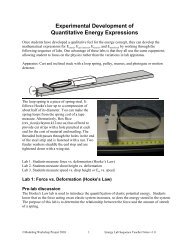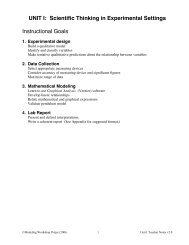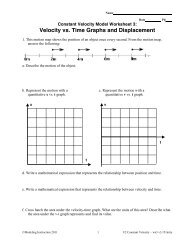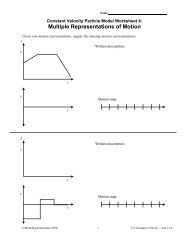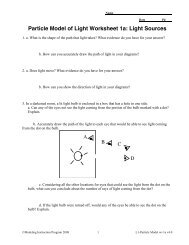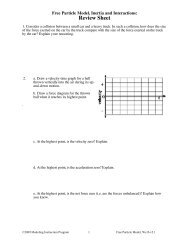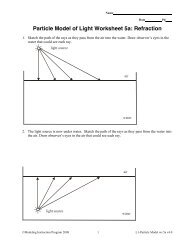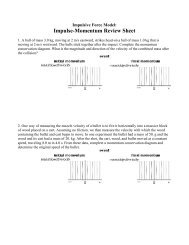Particle Model of Light Reading 2: Determining the Speed of Light
Particle Model of Light Reading 2: Determining the Speed of Light
Particle Model of Light Reading 2: Determining the Speed of Light
You also want an ePaper? Increase the reach of your titles
YUMPU automatically turns print PDFs into web optimized ePapers that Google loves.
<strong>Particle</strong> <strong>Model</strong> <strong>of</strong> <strong>Light</strong> <strong>Reading</strong> 2:<br />
<strong>Determining</strong> <strong>the</strong> <strong>Speed</strong> <strong>of</strong> <strong>Light</strong><br />
Anyone who has experienced a lightning storm intuitively knows that sound and light do not<br />
travel at <strong>the</strong> same speed. A flash <strong>of</strong> lightning is seen before thunder is heard, unless one is<br />
unfortunate enough to be very close to <strong>the</strong> location <strong>of</strong> <strong>the</strong> strike. It is obvious that sound travels<br />
at a finite speed. But what about light Do any readily observable phenomena suggest that light<br />
has a finite speed <strong>Light</strong> a candle or flip a light switch and light seems to instantly fill a<br />
darkened room. It is no surprise that in Galileo's day most thinkers believed that light had<br />
infinite velocity. Galileo, however, was not convinced <strong>of</strong> this.<br />
Galileo believed that light traveled at a finite speed, though he understood from observations <strong>of</strong><br />
cannon fire that light traveled much faster than sound (<strong>the</strong> fiery blast <strong>of</strong> a cannon can be seen<br />
from a distance before it is heard). In fact, <strong>the</strong> speed <strong>of</strong> sound had been measured with relative<br />
accuracy in Galileo's day by observing cannons fired from a distance and timing <strong>the</strong> delay<br />
between <strong>the</strong> appearance <strong>of</strong> fire from <strong>the</strong> end <strong>of</strong> <strong>the</strong> cannon and <strong>the</strong> arrival <strong>of</strong> <strong>the</strong> cannon's sound.<br />
Galileo attempted to determine <strong>the</strong> speed <strong>of</strong> light in a similar fashion by attempting to measure<br />
<strong>the</strong> time it takes for light from a lantern he uncovered to travel to an assistant and back again.<br />
The assistant would signal <strong>the</strong> arrival <strong>of</strong> Galileo's lantern light by uncovering a lantern <strong>of</strong> his<br />
own. In <strong>the</strong> end, Galileo succeeded only in roughly measuring human reaction times. Even<br />
when distances <strong>of</strong> a mile or more separated <strong>the</strong> experimenters, it was obvious that light traveled<br />
too quickly to be measured in this fashion. Many in Galileo's day continued to believe that light<br />
propagated instantaneously.<br />
In <strong>the</strong> 17th century, <strong>the</strong> triumph <strong>of</strong> Newton's Law <strong>of</strong> Universal Gravitation and <strong>of</strong> Kepler's Laws<br />
<strong>of</strong> planetary motion allowed astronomers to make extremely accurate predictions <strong>of</strong> planetary<br />
motions and positions. The four largest moons <strong>of</strong> Jupiter, which Galileo had discovered with a<br />
simple telescope, were no exception. Periodically, <strong>the</strong>se moons would disappear behind Jupiter<br />
and not be visible from Earth. The timing <strong>of</strong> <strong>the</strong>se eclipses was observed carefully and very<br />
accurate timetables were established. Galileo had even suggested that <strong>the</strong> motion <strong>of</strong> Jupiter’s<br />
moons could be used as a universal timekeeping mechanism because <strong>the</strong> eclipses would occur at<br />
<strong>the</strong> same time from any vantage point on Earth, which is not <strong>the</strong> case for phenomena associated<br />
with <strong>the</strong> sun, moon, or stars.<br />
One Danish astronomer, Olhaus "Ole" Roemer, made repeated observations <strong>of</strong> <strong>the</strong> eclipses <strong>of</strong><br />
Jupiter's moons.<br />
“As <strong>the</strong> moon moves around Jupiter, <strong>the</strong>re is a place<br />
(A to B) when <strong>the</strong> moon is in Jupiter's shadow - in<br />
o<strong>the</strong>r words, it is eclipsed as far as observations from<br />
<strong>the</strong> Earth are concerned. The Earth observations might<br />
be made from positions 1 and 2 <strong>of</strong> Earth's orbit about<br />
<strong>the</strong> sun; Jupiter's moon would <strong>the</strong>refore be seen to<br />
enter <strong>the</strong> shadow at A and emerge at B.<br />
“Roemer noticed that <strong>the</strong> time between eclipses<br />
(NOT <strong>the</strong> eclipse time) was 42 ½ hours when<br />
observed from points X or Y; that is, when <strong>the</strong> Earth<br />
was nei<strong>the</strong>r moving away from, or toward, Jupiter.<br />
©<strong>Model</strong>ing Instruction Program 2008 1 L1-<strong>Particle</strong> <strong>Model</strong> reading 2 v4.0
“But when <strong>the</strong> Earth was moving away from Jupiter (position 2) he noticed that <strong>the</strong> period was<br />
14 seconds longer. He deduced that light had to have a finite speed, because <strong>the</strong> 14 second lag<br />
indicated that <strong>the</strong> light had to "catch up" with <strong>the</strong> Earth (go a larger distance). Observations were<br />
made from many points on Earth's orbit. The details are more complex, but a summary <strong>of</strong> his<br />
observations is that he estimated that <strong>the</strong> time needed for light to travel a distance equal to <strong>the</strong><br />
diameter <strong>of</strong> Earth's orbit was 22 minutes (<strong>the</strong> modern value is 17 minutes).” 1<br />
The value that Roemer obtained was about 2.4 x 10 8 meters per second (150,000 miles per<br />
second). This is approximately eighty percent <strong>of</strong> <strong>the</strong> currently accepted value. Given <strong>the</strong><br />
relative simplicity <strong>of</strong> Roemer's equipment, his calculations <strong>of</strong> <strong>the</strong> speed <strong>of</strong> light were remarkable.<br />
Newton used Roemer's method to make calculations <strong>of</strong> this own, though his calculations were<br />
not much more accurate than Roemer's (Newton's values were actually slightly higher than <strong>the</strong><br />
currently accepted value). In <strong>the</strong> very least, Roemer's work <strong>of</strong>fered strong evidence for <strong>the</strong> fact<br />
that light, like sound, has a finite velocity.<br />
O<strong>the</strong>r significant efforts to measure <strong>the</strong> speed <strong>of</strong> light were conducted in <strong>the</strong> decades after<br />
Roemer. It wasn't until <strong>the</strong> late 19th century, however, that significant improvements in <strong>the</strong><br />
accuracy <strong>of</strong> measurement took place. An American astronomer, Alfred Michelson, used a<br />
different method than Roemer's. Simply summarized, his experiment used an eight-sided<br />
rotating mirror to reflect a light pulse toward a flat mirror located on a mountaintop 35 km (22<br />
miles) away. When <strong>the</strong> mirror rotated at <strong>the</strong> appropriate rate, <strong>the</strong> pulse <strong>of</strong> light reflected from <strong>the</strong><br />
rotating mirror to <strong>the</strong> distant mirror, and <strong>the</strong> back to <strong>the</strong> rotating mirror and into an eyepiece <strong>of</strong> a<br />
telescope through which Michelson could look for <strong>the</strong> pulse. The light pulse is visible only<br />
when <strong>the</strong> eight-sided mirror rotates one-eighth <strong>of</strong> a turn between <strong>the</strong> initial reflection and <strong>the</strong><br />
final reflection into <strong>the</strong> telescope. If <strong>the</strong> mirror rotates too fast or too slow, <strong>the</strong> pulse <strong>of</strong> light<br />
would reflect to one side <strong>of</strong> <strong>the</strong> eyepiece or <strong>the</strong> o<strong>the</strong>r and would not be seen. Because <strong>the</strong><br />
distance between mountaintops was known, and <strong>the</strong> time for one-eighth <strong>of</strong> a rotation at <strong>the</strong><br />
correct speed could be measured, <strong>the</strong> speed <strong>of</strong> <strong>the</strong> light pulse could be calculated.<br />
1<br />
This information was taken from Holton & Roller, Foundations <strong>of</strong> Modern Physical Science,<br />
Addison-Wesley Publishing Company, pages 551-552 (1958). H & R point out that "some <strong>of</strong><br />
Roemer's contemporaries attacked his result as implying a ridiculously large speed...o<strong>the</strong>rs<br />
continued to believe that <strong>the</strong> speed <strong>of</strong> light is infinite." Joseph R. Biegen<br />
http://web.sunybroome.edu/~biegen_j/phys2/light/jupiter.htm<br />
©<strong>Model</strong>ing Instruction Program 2008 2 L1-<strong>Particle</strong> <strong>Model</strong> reading 2 v4.0
During <strong>the</strong> decades in which Michelson carried out his research, he was able to obtain<br />
increasingly accurate measurements <strong>of</strong> <strong>the</strong> speed <strong>of</strong> light using this and o<strong>the</strong>r ingenious methods.<br />
One <strong>of</strong> <strong>the</strong>se experiments included <strong>the</strong> use <strong>of</strong> a mile-long vacuum tube that was intended to<br />
eliminate <strong>the</strong> effects <strong>of</strong> dust and o<strong>the</strong>r interfering factors in <strong>the</strong> atmosphere. Michelson was able<br />
to arrange mirrors in <strong>the</strong> tube so that a pulse <strong>of</strong> light traveled a total <strong>of</strong> ten miles back and forth<br />
in <strong>the</strong> tube before being observed.<br />
The currently accepted value for <strong>the</strong> speed <strong>of</strong> light is 2.99 x 10 8 meters per second, which is<br />
<strong>of</strong>ten rounded to 3.0 x 10 8 m/s. Michelson was eventually able to show (using a different<br />
experimental setup) that <strong>the</strong> speed <strong>of</strong> light is constant, even when <strong>the</strong> light source or <strong>the</strong> observer<br />
is moving. Though Michelson doubted <strong>the</strong> results <strong>of</strong> <strong>the</strong>se experiments, his work measuring <strong>the</strong><br />
speed <strong>of</strong> light was an important piece <strong>of</strong> evidence shaping Einstein's <strong>the</strong>ory <strong>of</strong> special relativity.<br />
The fact that light travels at a constant speed for all observers regardless <strong>of</strong> <strong>the</strong>ir motion became<br />
an axiom <strong>of</strong> Einstein's <strong>the</strong>ory.<br />
There are still numerous questions aimed at understanding exactly why light propagates at a<br />
specific velocity and why that particular velocity seems to be <strong>the</strong> cosmic "speed limit" for matter<br />
and energy in <strong>the</strong> universe. Is it possible, even for an individual photon, to travel faster that <strong>the</strong><br />
speed <strong>of</strong> light What would one experience traveling at such great speeds As is <strong>the</strong> case with<br />
many light related phenomena, deeper thinking about such curiosities leads to a host <strong>of</strong><br />
surprising conclusions and even more intriguing questions.<br />
©<strong>Model</strong>ing Instruction Program 2008 3 L1-<strong>Particle</strong> <strong>Model</strong> reading 2 v4.0




